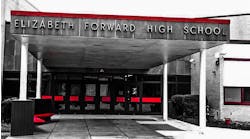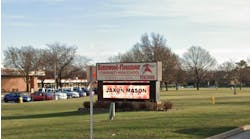Any school administrator complacent about school security was given a jolting wakeup call in 1999 when 15 people were killed in an attack at Columbine High School in Jefferson County, Colo. And any chance that those feelings of complacency might return vanished on Sept. 11, 2001, when the terrorist attacks on the United States made everyone aware how fragile our sense of security is — at home, work or at school.
To make sure schools provide buildings that are safe environments for students and staff, administrators can take numerous steps, including additional security personnel, training for staff members, education programs for students, and equipment that can monitor and control access to facilities.
“It can't be just one thing,” says Ellyn Dickmann, director of security and school operations in the Poudre School District in Fort Collins, Colo. “You need a whole host of things. You have to have a whole tool box that you can utilize.”
Here are 10 steps, in no particular order, which schools have found to be effective in keeping schools safe:
-
Crisis plan
When an emergency occurs at a school, it's important that staff members know how to react. Security professionals recommend that every school have an emergency-management or crisis plan.
“To have a crisis plan in place is critical,” says Gus Welborn, deputy director of school law enforcement for the Charlotte-Mecklenburg (N.C.) district. “People have to understand the specific things you need to do in case there is an incident.”
Most plans call for a school to establish a liaison with local law enforcement. As part of the plan, a school will designate a team of leaders who will take charge during a crisis, describe how to alert staff members that an emergency has developed (often through code words), and set up procedures for how to respond.
“We have direct contact with the local law enforcement and emergency services,” says Welborn.
Those connections helped last year when school officials had to deal with the threat of anthrax being sent through the mail. With a crisis plan in place and established relationships with other agencies, the district was able to assess the possible threats and take proper precautions in handling suspicious packages.
In many cases, institutions develop an overall crisis-management plan, and each school customizes it to fit their particular environment.
-
Training
Having a plan for dealing with crises is not enough. If a school is lucky enough not to have to call upon its plan for a long time, some staff members might not remember exactly how they are supposed to respond. That delay could have tragic consequences. Administrators must provide regular training to staff members so that a school's plan is more than just a document filed away in a drawer.
“People have to be comfortable knowing what they have to do,” says Welborn.
Since Sept. 11, many schools have beefed up their training to include information about weapons of mass destruction.
“It's a whole new ballgame,” says Dickmann. “We need to be better educated about what can happen.”
-
Technology
As prices drop and technical sophistication increases, equipment such as video surveillance has become a viable option for schools and universities. In Charlotte-Mecklenburg schools, although they have a deterrent effect, the cameras are used not so much to prevent an incident, but to piece together what happened after the fact. Welborn says students have become accustomed to the presence of the cameras and do not object.
“The kids really have accepted it,” says Welborn. “It has become an effective tool.”
Dickmann says that in the Poudre district, the security department works with each school to determine if it would benefit from video surveillance and helps buildings determine how many cameras it needs and where to place them.
“It's up to the school,” says Dickmann. “We don't do anything without first talking to the people at the school.”
-
Prevention programs
What schools do best is teach; so one of the best ways for schools to prevent violence and vandalism is to teach students how to avoid it and how to short-circuit a problem before it mushrooms into violence.
Schools have instituted bully prevention programs, brought in mental-health professionals to work with children, and established other intervention programs to help students deal with troublesome issues before they lead to violence.
-
CPTED
Once a school is built, it's more difficult to do something about a poorly placed administrative office, a facility with too many entrances and exits, or a corridor with too many hidden spots where trouble can occur.
But just as a poorly designed building can hinder security, so can a well-designed facility enhance the safety and well being of staff and students. Many architects and educators embrace the concept known as Crime Prevention Through Environmental Design (CPTED). CPTED encourages planners to incorporate safety elements into a building design at the earliest stages.
Schools designed with security in mind often will have administrative areas at the front entrance to the building, so that no one can come or go without being observed. The design will try to eliminate places where students can gather and not be seen by staff members. It will try to place entrances, parking lots and student gathering spots in locations that protect students and staff from traffic or outside intruders.
-
Fewer entrances
Many school facilities have numerous ways for students to get in and out. It may be convenient for students and staff to use the door closest to their parking lot or bus stop, but for security-minded administrators trying to control access to their facilities, it can be a nightmare. It costs too much to monitor each door, and it can be impractical to eliminate doors.
Many schools make sure that, once school is in session, only the front entrance can be opened from the outside. That way, all visitors must use the front entrance, where they are directed to check in at an administrative office.
For reasons of fire safety, most doors still must be able to open from the inside. To prevent students or staff members from propping open a door at an unsecured entrance, schools can install electronic sensors on the doors that will sound an alarm if a door is left open too long.
-
More police officers
More schools are recognizing that the presence of police officers in their buildings can not only deter crime and mischief, but also can enhance the atmosphere in the school. In some cases, institutions have their own force of sworn police officers; in other cases, districts employ private security guards. Many schools have resource officers who are members of a city or country police force that are assigned full-time to a school district. Regardless of which category they are in, they help schools create a safe environment.
“They develop relationships with kids,” says Dickmann. “They are our eyes and ears.”
The Poudre district encourages student-connection programs, in which officers set up basketball teams or weightlifting programs to build stronger bonds with students.
In Washoe County, Nev., which includes Reno, the school district assigns two officers to each high school.
“We try to keep them there for a four-year term,” says Washoe County school police officer Rich Rapisora. “We want them to see the freshmen graduate. That way, they can tell who should and shouldn't be there.”
-
Rapport with students
When New Bedford, Mass., uncovered a plot among students to carry out a Columbine-style attack on their high school, authorities said a key break on the case occurred when a student familiar with the plot confided in a teacher.
Schools encourage teachers and other staff members to get to know their students and be vigilant for those students who appear to be losing interest in their studies or getting into trouble.
-
Small schools
Schools that are victimized by student violence often learn after the incident that the students who committed the act felt anonymous and alienated at their schools. Studies have found that students are more likely to get lost in the shuffle in larger schools.
Advocates of smaller schools say that in addition to academic benefits from smaller learning communities, the more intimate atmosphere makes it easier for students to get to know each other and their teachers. Schools with large student populations often try to establish school-within-school units to create a learning community with a more manageable size.
-
Lighting
As communities are using school facilities more, the buildings are routinely occupied before the sun rises in the morning until long after it sets at night. Having sufficient lighting inside and outside a building helps protect students and community members attending activities after hours and can deter vandals or burglars who prefer to strike under the cover of darkness.
SIDEBAR: NOTABLE
-
133,700
Number of violent crimes committed against teachers at school (1994-98).
Source: Annual Report on School Safety, 2000 -
3,523
Number of students expelled for bringing a firearm to school (1998-99).
Source: Report on State Implementation of the Gun-Free Schools Act -
6,451
Number of schools that reported at least one incident of physical attack or fight with a weapon (1998).
Source: The National Study of Delinquency Prevention in Schools, 2000 -
5
Percentage of students ages 12 through 18 who reported fearing being attacked or harmed at school during the previous 6 months (1999).
Source: Indicators of School Crime and Safety 2000

